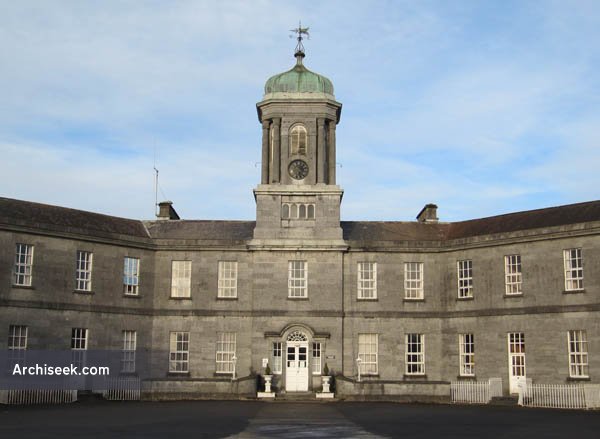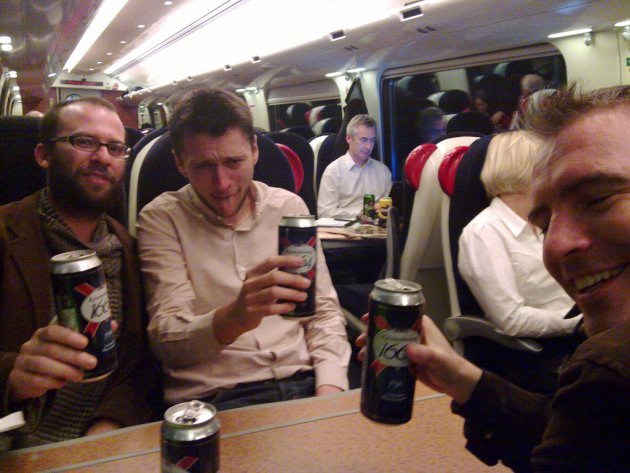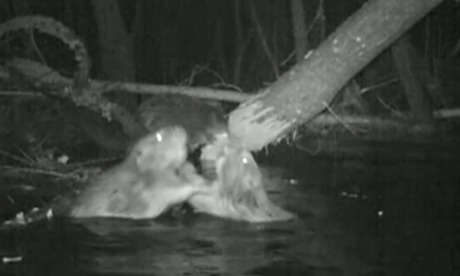Its the end of the line for drink after the 1pm Galway train joins the banned booze list
IRISH RAIL CUSTOMERS WILL HAVE ALCOHOLIC DRINKS CONFISCATED ON A TRAIN SERVICE AFTER COMPLAINTS ABOUT ANTI-SOCIAL BEHAVIOUR.
The action will immediately come into force on Sundays on the 1pm train from Galway to Heuston Station in Dublin, and catering staff will no longer sell alcohol on board.
Customers boarding the service with alcohol will have it taken away by Irish Rail staff.
Details of the ban will be displayed at stations, and customers booking online will also be notified during the reservation process.
It comes in addition to the ‘alcohol-free’ services operated on certain weekend routes, including the 1.15pm and 3.15pm services from Heuston Station to Waterford on Fridays, and the 3.05pm service from Waterford to Heuston Station on Sundays.
An Irish Rail spokesperson told the Irish Independent the decision had been made following a “high number” of complaints about anti-social behaviour on the train.
“The vast majority of customers who wish to enjoy an alcoholic beverage on board our services do so without impacting in any way on their fellow passengers.
“Unfortunately, there is a minority that do over-indulge, particularly those travelling in large groups such as stag and hen parties, who can disrupt others in a negative way.”
This type of behaviour was most common during weekend services, when customers may be going away for or returning from weekend breaks, Irish Rail said.
“It is a measure we take reluctantly, but we must act when our customers are regularly having their journeys disturbed by a minority.”
The spokesperson confirmed that the measure would be imposed for the “foreseeable future” and, as with all routes, would continue to be monitored for anti-social behaviour.
Irish Rail said said there were no plans at present to introduce the ban on other routes.
Irish Rail also deploys security staff on a number of routes known to play host to anti-social behaviour, including the aforementioned services between Waterford and Heuston Station and from Heuston Station to Galway on Friday afternoons.
It also prohibits the possession or sale of alcohol on some trains on major GAA match days.
Fionnuala Sheahan, director of Mature Enjoyment of Alcohol in Society (MEAS)said that for years Irish people had given social permission for people who drink too much to participate in anti-social behaviour, and that this was a clear message that Irish Rail “has had enough”.
Some 38.8 million passengers travelled with Irish Rail in 2009, down from 43.3 million passengers in the previous year.
€10m western Wild Atlantic Way driving route now launched
The Government is spending €10m on the Wild Atlantic Way this year, a 2,500-km driving route from Donegal to Cork aimed at attracting more visitors.
Launching the new initiative today, Junior Tourism Minister Michael Ring described it as “the world’s longest touring route”.
 It stretches along the coast from Malin Head in Donegal to the Old Head of Kinsale taking in over 500 visitor attractions, as well as 53 Blue Flag beaches, 120 golf courses and 50 loop walks.
It stretches along the coast from Malin Head in Donegal to the Old Head of Kinsale taking in over 500 visitor attractions, as well as 53 Blue Flag beaches, 120 golf courses and 50 loop walks.
Mr Ring said it was already providing a hit in key overseas markets like Britain, the US, France and Germany.
“It has massive potential to bring more visitors and jobs to rural communities right along the western seaboard. That’s why we will soon be promoting it even further afield in places like Spain, Italy and the Netherlands,” he said.
The government has allocated €8m for the project this year with Failte Ireland spending another €2m on some 159 “Discovery Point” sites highlighting key attractions such as the Cliffs of Moher in Clare and Dursey Island in Co Cork.
Nearly 4,000 new signs are being erected along the route in time for the start of the tourist season, while a new app is also being developed to assist visitors on the route.
One of Germany and Austria’s largest tour operators Dertour said it was featuring the route on the cover of its current brochure because it would appeal to customers.
“Germans love the coastline and they are always looking for outstanding scenery which they wouldn’t find at home,” said Dino Steinkamp of Dertour.
Irish action Plan for Jobs has 385 item to-do list but no strategy
The Irish Government has published its latest Action Plan for Jobs and it has a 385 item to-do list but there is still lack of a strategy.
So there are lots of points to cover but there is no evidence that ministers know what works and what doesn’t.
We noted last December that the much-hyped medium term strategy 2014-2020 would likely be a brochure rather than a plan with an unvarnished analysis of strengths, weaknesses, opportunities and threats. That is what was published.
It came just three months after the OECD’s Economic Survey of Ireland recommended empirically-proven policies and sunset clauses in enterprise and innovation supportsand we noted that there is no experience of this in the Irish system.
The OECD said the number of programmes and agencies multiplied during the period of booming growth. “There are now over 170 separate budget lines, sometimes for very small amounts of money, and 11 major funding agencies involved in disbursing the Science Budget, although it is small by international standards.”
This is boring to ministers but nobody else is in charge and for example enterprise agency heads say nothing of substance in public and possibly also in private.
Focus limited fiscal resources on policies empirically-proven to improve employability; this will require systematic evaluation of labour-market programmes through consistent tracking and randomised trials, followed by decisions to close down ineffective schemes while strengthening successful ones.
Reflecting significant uncertainties about the effectiveness of various innovation policy tools, independently and regularly evaluate all actions in this area, strengthen programmes with proven higher returns, and wind down the others. To promote effective evaluation, ensure all innovation and enterprise supports have sunset clauses.”
The latest university rankings shows that Ireland does not have a single university in the top 100 includes mathematics, physics, computer sciences, and all four of the engineering disciplines.
It’s daft to aspire to be world class in science and technology in a country with a tiny indigenous research base and more than 70% of foreign firms spending nothing on R&D.
The Department of Jobs, Enterprise and Innovation said last December:
Minister Bruton and the Department of Jobs are unashamedly ambitiousfor the potential of scientific research in Ireland to support economic growth and job-creation in Ireland. In recent years we have improved our ratings for basic research to the point where we are now very competitive internationally – the challenge now is to achieve greater returns in terms of commercial outcomes and jobs from this research.”
So they are “unashamedly ambitious for the potential of scientific research in Ireland” and this is effectively the main enterprise policy. An inflation adjusted €24bn has been spent in the past decade in this area and all they can cite are citations in journals while patent applications are at a 30-year low.
Phased redeployment of Irish hospital staff on the way


Staff from St Brigid’s Hospital in Ballinasloe will be redeployed on a phased basis to both community mental health teams in Ballinasloe, and to acute services in Galway and Roscommon, following a consultation process with “no impact for current inpatients in Ballinasloe,” Minister of State with responsibility for Mental Health Kathleen Lynch has stated.
Galway and Roscommon Mental Health Services operate as one administrative unit. At present, there are 35 acute psychiatric beds in Galway city, and 22 acute psychiatric beds in both Ballinasloe and Roscommon. This gives a total of 79 beds, serving a population of some 315,000.
A Vision for Change recommends 50 beds for a catchment population of 300,000. In line with policy and operational norms nationally, the provision of 22 beds in both Ballinasloe and Roscommon means that the current overall stock of 79 in the HSE West is too high in relative terms, allied to a corresponding under-development of community-based mental health services, Minister Lynch said in response to Dáil questioning by Deputy Denis Naughten.
In the context of the service improvements now underway, a purpose-built, 50-bed acute mental health unit will be completed in Galway University Hospital in 2015, to replace the existing smaller unit. This unit will consist of 35 general adult mental health beds, with the remaining 15 beds relating to psychiatry of later life, eating disorders and mental health and intellectual disability. The acute unit in Roscommon will continue to provide 22 general adult mental health beds.
The proposed reorganisation of services, following a detailed assessment by HSE West, will provide for a total of 57 general adult mental health beds. This will be a sufficient number of acute psychiatric beds, in line with A Vision for Change, and will also allow the Executive to enhance community-based services through redeployment of some staff from acute services, said Minister Lynch.
10 of the hottest Exercise trends for you to try out
Fed-up with your usual workout? Don’t despair, we have the solution. Our expert rates the 10 hottest exercise trends.
Bored of bootcamp and fed up of fitness DVDs? A new survey has found that we’d rather do anything OTHER than exercise, and this includes filling out tax returns, doing house work and even going to a Justin Bieber concert.
Here we reveal 10 new ways to take the weariness out of your workout – and personal trainer Darragh Hayes gives his expert verdict on each.
1 ONLINE TRAINING:
From broadband to waistband, virtual fitness could soon replace fitness DVDs for those looking to shape up at home. Dodging Storm Darwin while doing an exercise class with a real instructor anywhere in the world is just one of the advantages. But the Skype’s the limit.
EXPERT VIEW: “I do online training with clients, but I would only do it with those who already know what they’re doing. If you’re just starting out, it’s better to have somebody standing over you telling you exactly what to do.”
TRY IT: Natalie Portman’s trainer Mary Helen Bowers offers online ballet classes at http://www.balletbeautiful.com
2 RAVE FITNESS:
Dust down your Scooter CD and dig out those glow-sticks. Nineties-style aerobic raves – but with no booze or boys – are back. Clubbers burn up to 600 calories by dancing non-stop for an hour. Best of all, you wake up feeling perky not pukey the next morning.
EXPERT VIEW: “Jumping around like a maniac for an hour will certainly burn calories, but I’m not convinced it will actually burn fat or make you stronger. Be sure to drink lots of water.”
TRY IT: Women-only freestyle dance session ‘Dance Dance Party Party’ (see dancedancepartyparty.com for upcoming Irish dates)
3 OBSTACLE COURSES:
Beanbags are for babies. Today’s toughest obstacle courses for adults include crawling through mud, plunging into ice-cold water and scrambling over 12-foot walls.
Among the extreme outdoor challenges taking place here are Hell & Back, Tough Mudder and Runamuck. Less marathon than mad-athon.
EXPERT VIEW: “In terms of motivation, setting a goal to complete an outdoor challenge is a great idea. Just remember to get into the gym and start lifting to build strength as well!”
TRY IT: Tough Mudder Ireland 2014 takes place on October 4-5 at Punchestown Racecourse, Naas, Co. Kildare (see tough mudder.co.uk)
4 HYBRID EXERCISE:
First Brangelina and now ‘Piloxing’. That’s just one of the hybrid exercise classes springing up all over the country. As well as the fusion of Pilates and boxing, designed to offer the best of both, there’s ‘yogilates’ (yoga and Pilates), ‘zennis’ (zen and tennis) and ‘YAS’ (yoga and spinning). Perfect for indecisive exercisers – or is it?
EXPERT VIEW: “If you want to do Pilates, just do pilates; if you want to box, then box. Any good personal trainer should be able to integrate the strength and conditioning offered by both into your regular fitness regime.”
TRY IT: For a full list of Piloxing instructors in Ireland seehttp://www.piloxing.com
5 BODY-WEIGHT TRAINING:
Feel the burn using nothing but your own body. Forget the fancy gym equipment and go back to basics with press-ups, sit-ups, squat and lunges. It helps prevent osteoporosis, especially for women, by building stronger bones, costs nothing and you don’t even have to change out of your jammies. Triple whammy.
EXPERT VIEW: “Since injuring my back last year, body-weight training has helped recover my strength. I see people coming into the gym who can’t even hold a side plank for 10 seconds. It’s vital to get the basics right before so much as picking up a dumbbell.”
TRY IT: “When it comes to squatting, it’s a myth that you have to go ‘ass to grass’,” says Darragh. “Keeping your knees in front of your toes, squat until you’re parallel with the floor.”
6 ACTIVE SITTING:
Now you can shape up by literally sitting on your backside. Sedentary workers are increasingly throwing away their chairs in a bid to burn calories as they work. Instead, you balance on an inflatable exercise ball, which engages tummy muscles and improves your posture – not to mention your balance.
EXPERT VIEW: “Sitting on an exercise ball intermittently is fine, but for eight hours a day it could cause your core muscles to become fatigued. Doing bodyweight core exercises like the plank or side plank will have the same effect.”
TRY IT: Pro Fitness 65cm Gym Ball, €8.95, available from Argos.ie
7 GET-FIT GADGETS:
Fitness gadgets have come a long way since the humble pedometer. From smart scales that gauge your body-fat percentage to sweat-resistant headphones, losing weight has gone all hi-tech. Nike’s FuelBand activity tracker even reminds you to move if you’ve been watching telly for too long. Big blubber is watching you!
EXPERT VIEW: “No gadget is going to get your body fat down or build muscle, so don’t expect them to. If you’re hungry, eat. If you’re not, don’t. It’s as simple as that. Unless you’re training for a competition, I think fitness gadgets are a waste of time.”
TRY IT: Nike+ Fuelband SE, €139, available from store.nike.com
8 HIIT:
If you’re time poor, and not so flush with cash either, this year’s hottest trend for ‘High-Intensity Interval Training’ could be just the trick. Torching around 15 calories per minute, studies show that a 10-minute HIIT – including push-ups and burpees – burns more calories than half an hour on the treadmill. And, as it’s over in mere minutes, the boredom excuse is invalid.
EXPERT VIEW: “High-intensity interval training blows training on a treadmill or cross trainer out of the water. It’s great for losing fat and building muscle. Do it using your own body weight, or add weights for a tougher workout.”
TRY IT: The Fit Factory, Kells, Co Meath offers HIIT classes (see facebook.com/ fitfactorymeath)
9 ANTI-GRAVITY YOGA:
Super-toned singer Pink wowed with her aerial performance at the Grammys last month. And now more and more people here are hanging out at the gym too. The Cirque de Soleil-style classes involve practising yoga moves in a hammock for maximum flexibility.
EXPERT VIEW: “I have Olympic rings and TRX equipment in my gym that I use as part of any session. But I wouldn’t base a whole session around suspension training as there’s only so much you can do with it.”
TRY IT: For details of anti-gravity yoga classes available in Ireland, seehttp://www.antigravityyoga.ie
10 GROUP TRAINING:
You don’t have to be a celeb to afford a personal trainer – any more. Tighten your belt in more ways than one by simply sharing a trainer with one or more gym buddy. Mind you, even counting our Facebook friends, we probably still can’t afford trainer to the stars Tracy Anderson.
EXPERT VIEW: “I’m a stickler for technique. When you’ve got 25 or 30 people in a class, like some bootcamps, there’s no way you can ensure everyone is exercising correctly. For those who can’t afford one-to-one training, sharing a trainer is a great idea.”
TRY IT: The Cover Model Body Gym offers ladies-only group training (limited to six per class), €300 for 12 sessions (see covermodelbodypersonal training.com)
Wild beavers in England seen for first time in centuries
Footage of a family of beavers filmed in a Devon river is believed to be the first sighting of its kind in up to 500 years
Two beavers were caught on camera playing at night while a third one (in background) is gnawing a tree on the banks of the River Otter, Devon. Tom Buckley got the footage with a hidden infrared motion sensor camera. Photograph: Tom Buckley
A family of wild beavers has been seen in the England countryside in what is believed to be the first sighting of its kind in up to 500 years.
Three European beavers (Castor fiber), believed to be adults, have been filmed together on the River Otter in east Devon and can be seen gnawing at the base of trees, grooming themselves and playing together.
Experts said the sighting was “highly significant” as it strongly suggested a small breeding population of beavers now existed outside captivity.
European beavers were once widespread in the UK but were hunted to extinction by the 16th century in England and Wales for their fur, medicinal value and meat.
There have been successful reintroduction schemes in other parts of the UK. In 2009, three beaver families were released into forest lochs near the Sound of Jura in Argyll, while plans to release the species into the wild in Wales have also moved a step closer. The sighting in Devon would be the first time in centuries that European beavers have bred in the wild in England.
Wild beavers return to Scotland Link to video: How wild beavers made their return to Britain
The footage was captured by local retired environmental scientist Tom Buckley, who noticed some trees had been felled in the area in late last year. Together with landowner David Lawrence, he installed three motion sensor cameras along a 400-500m stretch of the river. A lone beaver was spotted on the farm in January and last July a woman claimed she saw a beaver on the river.
“We’d seen bits of trees chewed and cut down and I was starting to think that it was a sign of beavers even though I couldn’t believe it,” Buckley said.
Beaver expert Derek Gow confirmed that one of the animals filmed by Buckley was a juvenile and the family may have been in the wild for years. Buckley does not know where they have come from or exactly where their home is.
“When I first saw that first beaver it was such a shock. When I saw three it was slightly different – we knew there was one around and we were tracking its activities. When we watched film and all of a sudden another appeared, and then another – I would not just say that was amazing – one was speechless realising what was happening. We had no idea there was more than one, and they are all quite large and active as well.”
Devon Wildlife Trust has been running its own Beaver Project since 2011, when an adult male and female were introduced to a securely fenced compound in the north-west of the county.
But the beavers remain in their compound and are not the source of the population now seen on the River Otter.
Steve Hussey from the Devon Wildlife Trust said he supported the reintroduction of beavers to England but that it had to be “properly planned”.
“In principle, we would like to see the European beaver reintroduced to England but recognise that a great deal of work needs to be done before this can happen.”
He said the beavers should be left alone and observed using a rigorous monitoring programme.
“This group of beavers provides us with a unique opportunity to learn lessons about their behaviour and their impact on the local landscape … [the group] could contribute to this process if they are subjected to thorough scientific study.
Beavers are a “keystone species”, meaning they provide more important ecosystem services than their numbers alone would suggest. Known as “ecological engineers”, their dams, burrows and ditches and the branches they drag into the water create habitats for a host of other species. Their dams slow rivers down, reducing scouring and erosion, and improving water quality by holding back silt.
During the recent wet weather and flooding crisis, naturalists called for the reintroduction of beavers to control floods.
Otter tracks and spraint was found alongside the beaver prints, indicating they may have been interacting with wild otters too.
Hussey added: “There’s evidence that otters, beavers are coming together here face to face perhaps for the first time in two or 300 years.”
The Department for Environment, Food and Rural Affairs (Defra) is investigating the sighting as it is against the law to release beavers in England. A spokeswoman said the department would “look into this case and will consider what action to take”.
She said she could not comment on whether the beavers could be removed from the site or destroyed.
Buckley said: “This beaver family has been around for at least a couple of years and no one seems to have noticed them. They haven’t caused any trouble for anybody and it’s only because they’ve been caught on camera that people know they are here. To think about destroying them is totally out of order. This is an insight into what the potential impact is if they are already in a place and at the moment that impact would seem to be zero.”









No comments:
Post a Comment